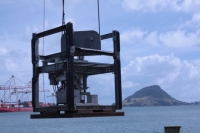Geotechnical in-situ and laboratory properties evaluation of low-strength on-shore and near-shore sediments in Germany and New Zealand
Dissertationskolloquium
Veranstalter: Mohammad Ehsan Jorat
Ort: GEO-GebÃĪude, Raum 1550 (HÃķrsaal)Beginn: 09.07.2014 18:00 Uhr

Peat stabilized with sand columns-columns geometry impact

GOST - Tauranga HarborAdvanced CPTu and laboratory investigation of geotechnically problematic on-shore and near-shore soft sediments in Germany and New Zealand
Supervisors: Prof. Dr. Tobias MÃķrz, Dr. Vicki Moon
Advisors: Dr. Stefan Kreiter. Dr. Willem de Lange
Ph.D. candidate: Mohammad Ehsan Jorat
The integrated Coastal Zone and Shelf Sea Research (INTERCOAST) organization, a cooperative German and New Zealand multidisciplinary research program, concentrates on scientific issues in social and natural science disciplines in the both countries. INTERCOAST 4 (IC4) Ph.D. program tackled geotechnically problematic soft soils such as peat, clay and clayey silts which have posed considerable challenges to geotechnical engineers in all parts of the world during design and construction process.
In Germany, peat is one of the prevailing groups of soil which is present in both off-shore and on-shore areas and exhibit properties such as high compressibility and low shear strength; these properties may cause complications such as differential settlement or failure in structures built on such soils. Removal or stabilization are the most important methods used to overcome geotechnical problems related to peat soilsâ engineering characteristics. In New Zealand, many off-shore and on-shore areas of the North Island are covered by volcanic ash, and weathering of this material has resulted in formation of clay minerals. Dredging of volcanic ash layers often causes major turbidity in the water column and poses risks to wildlife and humans. Due to very low effective shear strength and high sensitivity of volcanic ash, these sediments are not considered to be appropriate for off-shore construction and installation purposes. On-shore weathered volcanic ash having low permeability acts as a barrier to fluid flow, for example infiltration of rainfall, and prevents pore pressure from dissipating. This special characteristic may lead to failure of slopes with volcanic ash materials because increases in pore pressure lowers the effective normal (vertical) stress, and therefore shear strength.
The aim of this dissertation is to utilize in-situ and laboratory measurements in order to (i) present soil mechanical intervention for stabilization of peat using cost-effective and environmentally-friendly stabilization method and focus on a comparison between mechanical characteristics of undisturbed and stabilized peat, (ii) investigate geological setting, lithology and depositional history of off-shore sub-seafloor volcanic soils and determine geotechnical properties of near-surface sediments and (iii) look into the role of volcanic soils in occurrence of on-shore landslides.
In the laboratory, stabilization of peat was attempted using quartz sand. In order to stabilize the peat samples, cylindrical volume of peat were removed from a nearly undisturbed sample and replaced with sand. By adding sand columns to the peat, higher permeability, higher shear strength and a faster consolidation was achieved. This can be attributed to proper drainage provided by the sand columns which resulted in faster consolidation that leads to greater peat fiber interlocking. It was observed that the granular texture of sand also increased the friction angle of peat. Following the results of this laboratory study it appears that the introduction of sand columns could be suitable for geotechnical peat stabilization at the field scale.
Tauranga Harbor plays a key role in the New Zealand export-import industry, and plans currently exist for dredging and extending the harbor to accommodate larger container vessels. 2D and 3D sub-surface stratigraphy and near-surface materials physical properties of estuary sediments were investigated to evaluate the feasibility of dredging operations in the harbor. Six geological sequences were identified in the 2D stratigraphy; in ascending order they are Waiteariki Ignimbrite, Matua Subgroup, Te Ranga and Te Puna Ignimbrite, Pahoia Tephra, Hamilton Ash and Holocene marine sand. The Waiteariki Ignimbrite sequence may not be encountered in future dredging operations since it is the deepest sequence in this study and far below the current seafloor. Due to the Matua Subgroup and Te Ranga and Te Puna Ignimbrite sequences having stiff materials, special dredging machineries may be required. Pahoia Tephra and Hamilton Ash sequences are highly altered to clays making dredging easier. However, turbidity in the water column has to be considered. Holocene sequences within the previously dredged channel can easily be further dredged, while in undredged locations the sequence may be stiff and cemented.
In the Tauranga region, failure of sensitive soils commonly occurs after heavy rainfall events, causing considerable infrastructure damage. These failures are associated with materials loosely classified as the Pahoia Tephras - a mixture of rhyolitic pyroclastic deposits of approximately 1 Ma. Pore pressure and shear strength are two important parameters that control the stability of slopes. These parameters can be obtained from in-situ by CPT with pore pressure measurements. Results from static and vibratory CPT profiles deployed into two landslide headwall at Pyes Pa and Omokoroa Bay of Plenty, New Zealand are used to investigate the landslides. Static CPT results are used to evaluate soil grain size variations, geotechnical parameters of sediments such as shear resistance and sensitivity, and to identify the probable slip surface. Liquefaction potential of sediments is assessed using vibratory CPT results.
zurÞck

